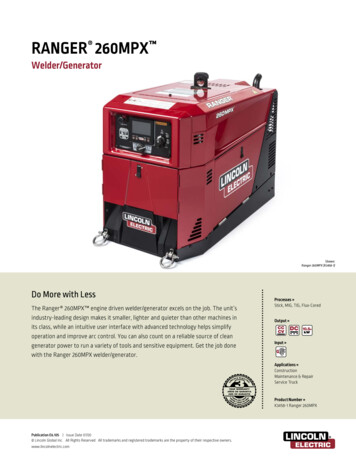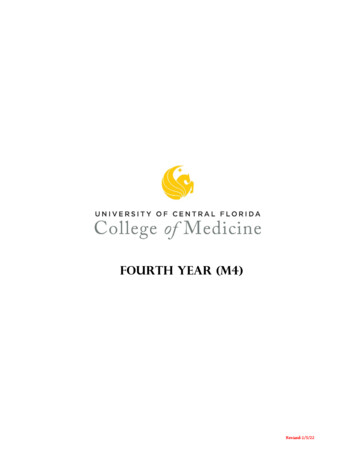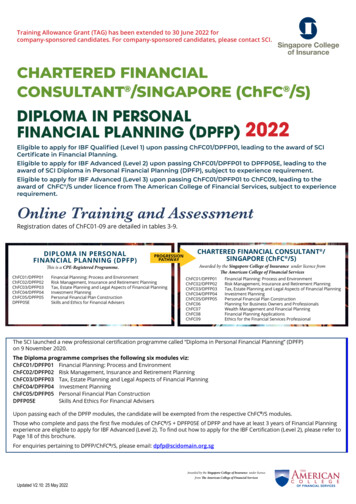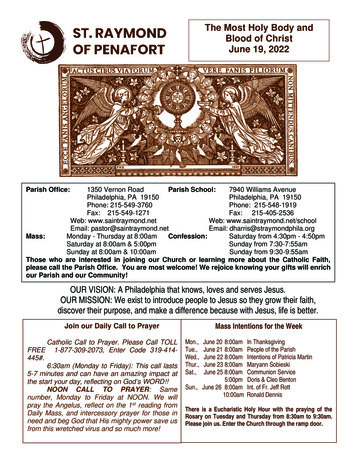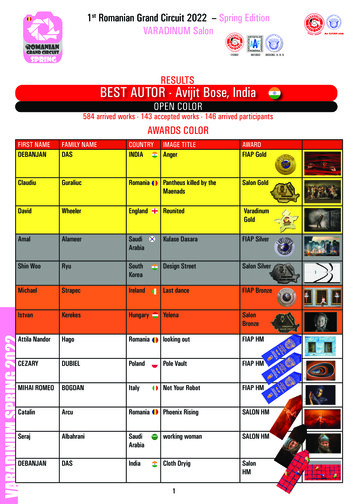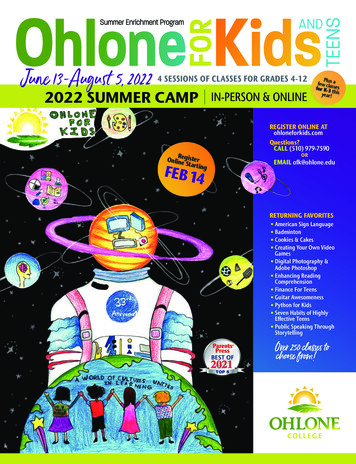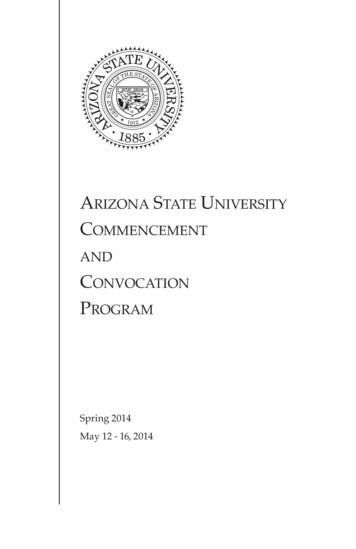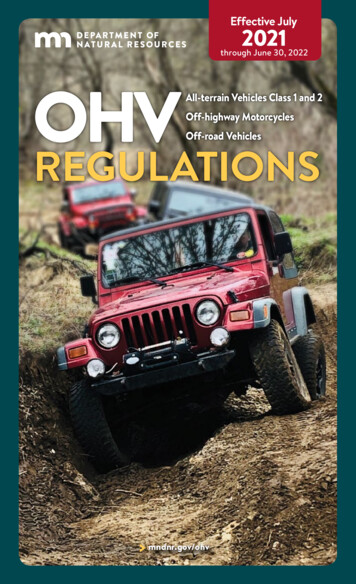
Transcription
Effective July2021through June 30, 2022OHVAll-terrain Vehicles Class 1 and 2Off-highway MotorcyclesOff‑road VehiclesREGULATIONSmndnr.gov/ohv
OHV DEFINITIONSOff-highway vehicle (OHV)The term off-highway vehicle (OHV) includes all-terrain vehicles (ATVs),off‑highway motorcycles (OHMs), and off-road vehicles (ORVs).All-terrain vehicle (ATV)ATVs have at least three, but no more than six, low-pressure or nonpneumatictires (not filled with or containing compressed air) with a total dry weight lessthan 2,000 pounds and a total width from outside of tire rim to outside of tire rimthat is 65 inches or less. ATVs include Class 1 and Class 2. Dry weight is normallythe weight of the vehicle without fluids. Vehicles not considered ATVs includesgolf carts, mini-trucks, dune buggies, go carts, or a vehicle designed and usedspecifically for lawn maintenance, agriculture, logging, or mining purposes.Class 1 ATVswidth 50 inches or less.Class 2 ATVs width greaterthan 50 inches but notmore than 65 inches.Off-highway motorcycle (OHM)“Off-highway motorcycle” means a motorized, off-highway vehicletraveling on two wheels and having a seat or saddle designed to bestraddled by the operator and handlebars for steering control, includinga vehicle that is registered under chapter 168 for highway use if it is alsoused for off-highway operation on trails or unimproved terrain.Off-road vehicle (ORV)“Off-road vehicle” or “vehicle” means a motor-driven recreationalvehicle capable of cross-country travel on natural terrain withoutbenefit of a road or trail.Off-road vehicle does not include a snowmobile; an ATV; a motorcycle; awatercraft; a farm vehicle being used for farming; a vehicle used for military, fire,emergency, or law enforcement purposes; a construction or logging vehicle usedin the performance of its common function; a motor vehicle owned by or operatedunder contract with a utility, whether publicly or privately owned, when used forwork on utilities; a commercial vehicle being used for its intended purpose; snowgrooming equipment when used for its intended purpose; or an aircraft.Approved helmetAn approved helmet is required to meet DOT specifications. DOT is themanufacturer’s certification that the helmet conforms to the applicable federalmotor vehicle safety standards. Bicycle and hockey helmets are not legal helmets.DOTOHV Definitions3
ATV MINNESOTAYour Voice for ATV Recreation in MinnesotaRepresenting 70 ATV clubs thatbuild and maintain our trail system 20MEMBERSHIPMembership includessubscription toMinnesota WheelinmagazineFor Membership DetailsJoin todayat atvam.orgor call 800-442-8826Paid advertisementINVASIVE SPECIESIf you ride ATVs, OHMs, or ORVs, start the day with clean shoes and gear by usinghandheld boot brush to ensure there were no missed seeds or plant parts from yourlast adventure.Stay on marked and/or designated trails to keep invasive species populationslocalized for easier management and prevent spreading to new areas.When you’re adventure is done and before leaving a location, Clean your clothesand gear by picking off seeds and burrs and brushing off extra soil.Spray down your OHV with water or compressed air to remove mud and plant partsfrom tires and fenders. Follow these simple steps to Stop Invasive Species in Your Tracks Remove plants, animals and mud from boots, gear, pets,and vehicle. Clean your gear before entering and leaving therecreation site. Stay on designated roads and trails.
TABLE OF CONTENTSOHV Definitions3DNR Conservation Officers Riding Tips7Frequently Asked Questions8Off-highway Vehicle Registration10All-terrain Vehicle (ATV) Operation16General Operations of ATV, OHM and ORV22Off-highway Motorcycles (OHM)26Off-road Vehicles (ORV)29Trail Passes30Equipment Requirements for ATV, OHM and ORV31Enforcement31Public Lands and Trails34For More Information39WHAT’S NEWAs of July 1, 2021 - Driving While Impaired If an operator’s license is revoked, suspended or canceled due to a DWIviolation, they cannot legally operate any vehicle, including Off-roadrecreational vehicles. If an operator is participating in the ignition interlock device program, theycannot operate an off-road recreational vehicle or a motorboat.A common question is “Can I drive my truck (that has interlock device) to the lakeand then unload my ATV to go ice fishing?” The answer is NO, you cannot operatethe ATV because no ignition interlock devices have been approved for off-roadrecreational vehicles, motorboats, or highway licensed motorcycles.Regulations in this booklet are effective from July 1, 2021 through June 30, 2022.Cover photo: Minnesota Four Wheel Drive AssociationThis publication is partially funded through advertising revenue. The State ofMinnesota and the Minnesota Department of Natural Resources (DNR) canneither endorse the products or services advertised nor accept any liability arisingfrom the use of these products or services.
2020 ATV Volunteer Instructor of the YearThe Minnesota Department of Natural Resources has named David AndrewsJr., a volunteer ATV safety instructor in Grand Rapids, as the 2020 ATVinstructor of the year.Andrews, an active and founding member of the Rapids Riders ATV Club, hasbeen a volunteer ATV safety instructor and active in the DNR’s VolunteerTrail Ambassador program since 2007. In that time, he’s taught about 1,200students as part of 40 classes. In addition, he’s a volunteer firearms safetyinstructor and active in several other local and statewide conservation andcommunity organizations.“Whether he’s teaching new riders in class, or reinforcing safe ridinghabits among the people he meets on the trail through his work as a TrailAmbassador, David has a long track record of helping people enjoy theoutdoors safely,” said DNR Conservation Officer Tom Sutherland, who isstationed in Grand Rapids. “He goes above and beyond to ensure peoplehave the skills they need to enjoy a lifetime of safe riding.”Learn how you can become a DNR youth volunteer instructor at:mndnr.gov/safety/instructorsConservation Officer Thomas Sutherland and volunteer instructorDavid Andrews Jr.62020-2021 OHV Regulations 888-MINNDNR
DNR ConservationOfficers (CO) Riding TipsHeadlights on for SafetyMinnesota law says, a personmay not drive or operate anall-terrain vehicle withoutheadlight and taillight lightedat all times if the vehicle isequipped with headlight andtaillight. Read the owner’s manual.Recommend everyone should take a safety training course.Wear helmets at all times.Fasten seatbelts at all times.Headlights are required by law when operating an ATV at all times.Always supervise young or inexperienced riders.Avoid alcohol or drugs.Stay to the right on trails and be aware of oncoming traffic.Maintain safe distances when following other riders.Reduce your speed on corners and when riding at night.Always yield to other motor vehicles and trail users.For current trail conditions, map downloads, nearbyservices, and more, check out www.mndnr.gov/ohvOHV Definitions7
FREQUENTLY ASKED QUESTIONSWHERE TO RIDEQ: Can I drive my ATV on the side of a road or city street?A: It depends on the type of ATV and Age of operator. Check with local county andcity officials or road authority.Q: Can I operate an OHM in the ditches?A: No, OHMs cannot be operated in ditches unless on a designated trail thatincludes OHMs.Q: Do I need a valid driver’s license to operate an ATV?A: It depends on where you operate your ATV. A driver, age 16 and older, will needa valid driver’s license to make a direct crossing of a roadway or operate within theroad right-of-way. A valid driver’s license is not needed for operation on state ATVtrails.Q: Can I ride my ATV or OHM on a snowmobile trail?A: No, most snowmobile trails cross private lands that only allow public use duringthe winter season by snowmobiles. Any other use may be considered trespassing.Exception: Trails and roads on state forest lands remain open to public use untilgroomed unless signed “closed.”Q: Where can I ride my Class 1 ATV?A: For a list of trails for Class 1 ATVs, see the riding opportunities at mndnr.gov/ohv.EQUIPMENTQ: Where can I ride my ATV if I put tracks on it?A: Once you put tracks on a Class 1 or Class 2 ATV it is considered an ORV. You mayoperate: on frozen waters on state forest roads in state forests classified as “limited” or “managed” in ORV special use areas on Private property with permission of landownerQ: Can I have an infant or toddler ride with me?A: By law, anyone under age 18 is required to wear a DOT approved helmet(see page 3) and seat belts (if equipped). Adult/teen size helmets are not suitablefor infant/toddlers as they don’t have sufficient neck muscle strength to holdup a helmet. To improve safety of youth riding in an ATV, a belt-positioning boosterseat can be used to fit a seat belt properly.Continued 82020-2021 OHV Regulations 888-MINNDNR
OFF-HIGHWAY VEHICLE REGISTRATIONQ: How and where do I register an OHV?A: You must be at least 18 years old to register. Go in person to any deputy registraroffice (where automobile license tabs are purchased) or at the DNR License Centerin St. Paul. You will be provided a registration card and decal for your off-highwayvehicle. You may renew your OHV registration online at mndnr.gov/licenses/ohv.Q: What information do I need to register an OHV?A: Need to have the make, model, year, serial number, and sales receipt or billof sale. For OHM registration, the engine size is required. For ATV registration,along with engine size, the dry weight and width from outside rim to outside rimis required.Q: I purchased at a dealership, how do I apply for registration?A: ATVs and OHMs purchased from a retail dealer must be registered withthe DNR on behalf of the customer. The dealer will issue a temporary 21-dayregistration. A registration card and an expiration decal.Q: What if I sell my OHV?A: If you sell your OHV, give the new owner a signed bill of sale that includes theserial number of the vehicle along with make and model. The serial number can befound on the registration card.Q: What if I buy a OHM or ATV from another owner?A: The new owner must report the transfer of ownership within 15 days of the saleat a deputy registrar office or at the DNR License Center in St. Paul. A new ownercan be charged with a misdemeanor for failure to file and transfer ownership within15 days of the sale.Q: Does my ATV need to have registration to operate on frozen waters?A: Yes, ATV public use registration is needed if it will be driven on public trails,public land, frozen water or the roadway.Q: I’m a Minnesota resident and my ATV is registered in Wisconsin.Do I need the nonresident trail pass?A: No, residents do not need this trail pass even if their vehicle is registered in adifferent state.Q: I have a Private/Agricultural Use registration on my ATV, now I want togo use it on a state ATV trail. Can I operate on the trail?A: No, you will need to purchase a Public Use Registration (3 year registration)before operating on state or grant-in-aid ATV trails.Frequently Asked Questions9
OFF-HIGHWAY VEHICLE REGISTRATIONAll off-highway vehicles must be registered to operate in Minnesota. Fees foroff‑highway vehicle registrations go into specific vehicle fund accounts that payfor trail maintenance, safety training and enforcement.ATV REGISTRATIONAll-terrain vehicles can be registered as either a Class 1 ATV or a Class 2 ATV(see page 3 for definitions). All ATVs operated in Minnesota must be registeredwith the DNR, including those used exclusively on private property. See exceptionspage 11. Class 1 or Class 2 will be indicated on the owner’s ATV registration cardand decal.Display of numbers and decals for ATVsRegistered ATVs must display the current public use registration number anddecal(s) on a plate as indicated below. The plate and decal must be maintained in aclear and legible condition.Registration plate must be: at least 4 inches high and 71 2 inches long; clearly visible on the back of the vehicle; and at least 12 inches from the ground.Registration letters and numbers must be: at least 1½ inches high with a 3 16 inch stroke; in English and placed from left to right; and in a color that contrasts with the background of the plate.What type of registration is needed?Minnesota Department of Natural ResourcesATV Class 1 Vehicle Registration DecalAgentTID9922038241664 Inches2017 YAMAHA1AF2305/29/201911:10Txn# 568683597 ½ InchesMinnesota Department of Natural ResourcesAgricultural All-Terrain Vehicle Registration DecalAG 1AF23This registration expires upon transfer of ownership.2017 YAMAHAAgent 9922005/29/2019 11:10Txn#56868359TID 38241664 InchesPrivate/agricultural use If you will use your ATV (Class 1 or Class 2)exclusively for private or agricultural activities,harvesting wood, or on private property. The decal must be displayed in the upper rightsection of the plate. This registration does notexpire and is valid until the ownership of the ATVis transferred.2021Expires: DEC. 31,2021Reg # 1AF23Public use If you will ride this ATV on public ATV trails, publicland, frozen water and roadways. The decal must be displayed in the upper leftsection of the plate. This registration is valid forthree years. Registration expires on December 31of the third year.7 ½ InchesContinued 102020-2021 OHV Regulations 888-MINNDNR
MinnesotaDepartmentDepartmentofof NaturalNatural ResourcesResourcesMinnesotaMinnesota Department of Natural ResourcesATV Class 1 Vehicle Registration DecalAgricultural All-TerrainAll-Terrain VehicleVehicle RegistrationRegistration DecalDecalAgricultural2017 YAMAHAReg # 1AF23AG 1AF23AgentTID9922038241664 onupon transfertransfer ofof ownership.ownership.This2017YAMAHAYAMAHAAgent 9TID 201911:10Txn# 568683597 ½ Inches9999Minnesota Department of Natural ResourcesCollector ATV Class 1 Vehicle Registration DecalV03202Expires: DEC. 31,999905/29/201911:10Txn# 56868359AgentTID9922038241664 Inches1988 YAMAHACollector use If your ATV is 25 years or older. ATVs 25 years and older are exempt fromregistration if they were originally produced as aseparate, identifiable make by a manufacturer. Thisregistration is nontransferable.2021Expires: DEC. 31,2021Reg # V03202Both public and private use registration The public use decal and private use decal must bedisplayed in the appropriate section of the plate.Public use decal on the upper left and private use inthe upper right and a series of letters and numberalong the bottom.7 ½ InchesExemptionsThere are exemptions provided by law. If your answer is “YES” to any of thestatements below, registration is not required.If you are operating an: ATV, OHM or ORV registered in another state or country and not in Minnesotafor more than 30 consecutive days. ATV, OHM or ORV owned by federal, local and tribal governments. ATV that is used exclusively in organized track racing events. ATV owned by a resident of another state or country that does not requireregistration of the ATV, not in Minnesota for more than 30 consecutive days,and is operated on state and grant-in-aid trails by a nonresident possessing anonresident state trail pass. ATV that is registered by an Indian tribal government to a tribal memberand has not been outside the tribal reservation boundary for more than30 consecutive days. ATV that is 25 years or older (see above). ATV on a state and/or grant-in-aid trail on June 11-13, 2021, Free RidingWeekend. (ATV registration and nonresident ATV trail passes will not berequired to ride on state and grant-in-aid trails those days.) OHM operated by a person participating in an event for which the MinnesotaDNR has issued a special use permit exempting the registration or nonresidenttrail pass requirements. OHMs not in Minnesota for more than 30 consecutive days and are operatedon state and grant-in-aid trails by a nonresident possessing a nonresident statetrail pass. OHM or ORV licensed for highway use when operated on forest roads. ORV operated on frozen waters or private property (not a designatedORV trail).FREE RIDING WEEKENDATV registration and nonresident ATV trail passes will not berequired to ride on state and grant-in-aid trails on June 10-12, 2022.Off-highway Vehicle Registration11
OHM REGISTRATIONAll OHMs operated in Minnesota must be registered with DNR. See page 11 forexemptions. Even when operated on private property, registration is required.This registration is valid for three years.OHM recreational registration and highway use licenseSome OHMs are equipped so that they may be legally licensed for highway use.An OHM licensed for highway use which is also used off-road must have both theregular motorcycle license and the DNR OHM registration. An OHM registeredfor off-road use may also be licensed for highway use if properly equipped.Equipment requirements include: headlights, taillights, mirrors, horn, and othermodifications. Contact the Department of Public Safety for further details andapplication procedures.OHMs licensed in Minnesota for roadway use andregistered for off-road useDisplay the OHM decal in the upper left corner of the rearregular motorcycle license plate. The DNR registrationnumber should not be displayed.OHMs registered only for off-road useIf the motorcycle is not licensed as a motor vehicle, thedecal must be attached on the side of the motorcycleand may be attached to the fork tube. The decal must beattached in a manner so that it is visible while a rider is onthe motorcycle.REPLACEMENT REGISTRATION CARDS AND DECALSYou may obtain a ATV and OHM replacement registration card for 10.00 or areplacement decal for 6.00 from the DNR License Center or a deputy registraroffice (where automobile license tabs are purchased). Replacement decals andnumbers must be affixed in the same manner as the original. You are not requiredto carry the registration card, but when a law enforcement officer requests to seeit, it must be provided within a reasonable time period.122020-2021 OHV Regulations 888-MINNDNR
ORV REGISTRATIONAll ORVs operated on DNR designated or grant-in-aid ORV trails or recreationalvehicle use areas must be registered with the DNR. This registration is valid forthree years.ORV recreational registration and highway use licenseAn ORV licensed for highway use which is also operated on designated public ORVuse areas or trails must display the regular vehicle license plate and DNR ORVregistration decal.ORV registered only for off-road useDisplay the current decal on a plate at least 4 inches highand 7½ inches long. No registration number should bedisplayed. The plate must be clearly visible on the backof the vehicle and at least 12 inches from the ground.The decal must be displayed in the upper left corner of theplate. The plate and decal must be maintained in a clearand legible condition.ORVs licensed in Minnesota for roadway use andregistered for off-road useIf the vehicle is licensed as a motor vehicle, theregistration decal must be affixed on the upper leftcorner of the rear license plate.ORV REGISTRATION-FREE DAY AT THE IRON RANGEOHV RECREATION AREAOn May 21, 2022, the Iron Range Off-highway Vehicle Recreation Area willnot require registration from any ORV riders that visit the site. The ORVregistration-free day falls on the third Saturday in May each year.Continued Off-highway Vehicle Registration13
DEALER AND MANUFACTURER REGISTRATIONREQUIREMENTSRegistration is required by OHV dealers and manufacturers to operate OHVsfor testing or demonstration purposes. OHV dealerships and manufacturers maymake application for registration at local deputy registrar office and directly withthe DNR License bureau in St. Paul. Registration plates will be sent out from thelicense bureau.The registration certificate documents must be prominently displayed in the placeof business.The registration plate must be displayed on the OHV before dealers ormanufacturers may operate or allow operation of any off-highway vehiclethey own.REGISTRATION FEESAll-terrain vehicle registration fees - effective 07/01/2017TYPE OF TRANSACTIONNew (unregistered)Renewal onlyTransfer onlyRenewal and transferDuplicate registration cardDuplicate registration decal onlyDealer’s registrationDealer’s registration renewalManufacturer’s registrationManufacturer’s registration renewalNonresident trail passDuplicate nonresident trail passNew collector ATVDuplicate collector 50.0030.002.006.004.00ISSUING FEE DURATION8.503 calendar years6.003 calendar 001 year1 year1 year1 year1 yearNonexpiringPrivate/agricultural registration fees - effective 07/01/2017TYPE OF TRANSACTIONNew (unregistered)Duplicate registration cardDuplicate registration decal only142020-2021 OHV RegulationsFEE6.004.000.00ISSUING FEE DURATION8.506.006.00 888-MINNDNR
Off-road vehicle registration fees - effective 07/01/2017TYPE OF TRANSACTIONNew (unregistered)Renewal only30-day resident trail passFEE30.0030.0020.00ISSUING FEE8.506.001.00Transfer onlyRenewal & transferDuplicate registration cardDuplicate registration decal onlyDealer’s registrationDealer’s registration renewalManufacturer’s registrationManufacturer’s registration renewalOne-year nonresident trail passThree-year nonresident trail passDuplicate nonresident trail DURATION3 calendar years3 calendar years30 consecutivedays1 year1 year1 year1 year1 year3 yearsOff-highway motorcycle registration fees - effective 07/01/2017TYPE OF TRANSACTIONNew (unregistered)Renewal onlyTransfer onlyRenewal and transferDuplicate registration cardDuplicate registration decal onlyDealer’s registrationDealer’s registration renewalManufacturer’s registrationManufacturer’s registration renewalOne-year nonresident trail 150.0020.00ISSUING ATION3 calendar years3 calendar years1 year1 year1 year1 year1 yearOff-highway Vehicle Registration15
ALL-TERRAIN VEHICLE (ATV) OPERATIONATV SAFETY TRAINING REQUIREMENTSOTA CERTESISAFETYATVEDFIAn individual who was born after July 1, 1987, andwho is 16 years of age or older, must successfullycomplete the independent study course componentof all-terrain vehicle safety training before operatingan all-terrain vehicle on public lands or waters, publicroad rights-of-way, or state or grant-in-aid trails.MINNThese requirements are for residents and nonresidents.Exception: A person at least 10 years of age butunder 12 years of age may operate an all-terrain vehiclewith an engine capacity up to 110cc if the vehicle is a Class1 all-terrain vehicle with straddle-style seating or up to 170cc if the vehicle is aClass 1 all-terrain vehicle with side‑by‑side-style seating on public lands or waters ifaccompanied by a parent or legal guardian.The Minnesota DNR ATV Safety class includes information on: basic operation,common parts and controls, operating safely and responsibly, trail riding, laws,riding skills, and protecting the environment.Ages 10 to 15Youth will complete the two-step process to ATV Safety Certification:1. Complete the ATV safety online training course.2. Attend a hands-on ATV course.Online training course: atvcourse.com Fee: 24.95Hands-on ATV course: Find a schedule of hands-on courses atmndnr.gov/safety/vehicle/atv. Go to Education and Safety tab, and then underrecreational vehicle safety classes, click on ATV Safety to find the hands-on ATVcourse calendar. Additional fees may apply when attending the hands-on ATV course. Student is required to fit their ATV in order to participate in the ATV course.See page 21. Contact the lead ATV instructor for additional information.Ages 16 and olderAnyone who is 16 years or older must successfully complete the online ATV SafetyTraining before operating an ATV on public lands, frozen waters, public roadrights‑of-way, or state or grant-in-aid trails. Not required to attend the hands-onATV course.162020-2021 OHV Regulations 888-MINNDNR
Alternate ATV safety training certificationProof of completing an ATV safety course that includes a riding componentoffered by the ATV Safety Institute (ASI) or another state is adequate to meet theATV safety certification requirements of Minnesota.For information about safety training classes, call the DNR Safety Training Programat 800-366-8917 or go to mndnr.gov/safety/vehicle/atv.Hands-on ATV courseFind a schedule of hands-on courses at mndnr.gov/atv. Go to Education and Safetytab, and then under recreational vehicle safety classes, click on ATV Safety to findthe hands-on ATV course calendar.ALL-TERRAIN VEHICLE (ATV) OPERATIONS FORCLASS 1 AND 2Safety first—helmetsOperators and passengers under age 18 are required to wear a helmet whenoperating on public lands, frozen waters, and road rights-of-way. See page 3 for thedefinition of an Approved Helmet.Safety first—seat beltsThe U.S. Product Safety Commission and the Minnesota DNR recommends allriders use seat belts if equipped by the manufacturer. Potential for severe injuryand death are greatly reduced with wearing seat belts.Under Minnesota Law: A person less than 18 years of age shall not ride as apassenger or as an operator of an all-terrain vehicle without wearing a seat beltwhen provided by the manufacturer.A person may not drive or operate an all-terrain vehicle: at a rate of speed greater than reasonable or proper under the surroundingcircumstances; in a careless, reckless, or negligent manner so as to endanger or to cause injuryor damage to the person or property of another; without headlight and taillight lighted at all times if the vehicle is equipped withheadlight and taillight; without a functioning stoplight if so equipped; without a brake operational by either hand or foot; with more than one person on the vehicle, see Passenger sections under Class 1and Class 2 ATV; at a speed exceeding 10-miles per hour on the frozen surface of public waterswithin 100 feet of a person not on an all-terrain vehicle or within 100 feet of afishing shelter; across a bridge that is part of the traveled lanes of an interstate highway; or on grant-in-aid snowmobile and non-motorized trails closed to ATVs unlessspecifically allowed.All-terrain Vehicle (ATV) Operation17
CLASS 1 ATV OPERATIONSThe owner or adult in control of an ATV is legally responsible to ensureit is operated according to the following requirements.Under age 10 May operate only on private property with permission of the owner.Ages 10 and 11 May operate only on private property with permission of the owner, except anATV with a straddle seat up to 110cc or up to 170cc with side-by-side seating onpublic lands and frozen waters if accompanied by parent or legal guardian.Ages 12 to 15 Must have permission from their parent or guardian to operate an ATV. May not operate an ATV on public lands or water, or on state or grant-in-aidtrails, if the person cannot properly reach and control the handlebars and reachthe foot pegs while sitting upright on the seat. May make a direct crossing of a public road right-of-way of a trunk, countystate-aid, or county highway or operate on public lands and waters or state orgrant-in-aid trails, only if that person possesses a valid all-terrain vehicle safetycertificate issued by the commissioner and is accompanied on another ATV bya person 18 years of age or older who holds a valid driver’s license. May operate on the bank, slope, ditch of a public road right-of-way or roadwayopen by local ordinance with a valid ATV Safety Certificate when accompaniedby a parent or legal guardian on a separate ATV.Ages 16 and 17 Must have a valid driver’s license and ATV Safety Certificate to make a directcrossing of a roadway or operate on road rights-of-way or roadway open bylocal ordinance.Private PropertyPublic Road Right-of-WayRoadwayDitchUnless allowed by local or countyordinance, Class 1 ATVs cannot beoperated on the road surface.DitchA person shall not operate an all-terrain vehicle at any time within the right-of-wayof an interstate highway or freeway within this state.Continued 182020-2021 OHV Regulations 888-MINNDNR
Passengers on a Class 1 ATV (MN Statute 84.9257 Passengers) A person 12 to 17 years of age may operate a Class 1 all-terrain vehicle carryingonly one passenger and the passenger must be the person’s parent orlegal guardian. A person 18 years of age or older may operate a Class 1 all-terrain vehiclecarrying only one passenger.A person with a valid driver’s license may operate a Class 1 ATV: In the ditch or the outside bank or slope of a trunk, county state-aid, or countyhighway unless prohibited under local road authority. Registered for private use and being used for agricultural purposes on a publicright-of-way of a trunk, county, state aid, or county highway, if the ATV is on theextreme right side of the road. A left turn may be made if it is safe to do so. On the far right side of a township road, unless prohibited by local regulations.If traveling at a slower speed than other traffic on the township road, the ATVshould be driven as close as practical to the right edge of the road. On a bridge, a roadway shoulder, or the inside bank of a public road right-of-wayif necessary to avoid obstructions to travel or environmentally sensitive areas.You must remain in the farthest right lane, enter the roadway within 100 feet ofthe bridge, obstacle, or area, and make the crossing without delay.Class 1 ATV with steering wheelA person may operate a Class 1 all-terrain vehicle designed by the manufacturerfor off-road use to be driven by a steering wheel and equipped with operator andpassenger seat belts and a roll-over protectiv
OHV Definitions 7 Read the owner's manual. Recommend everyone should take a safety training course. Wear helmets at all times. Fasten seatbelts at all times.
